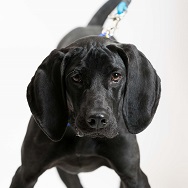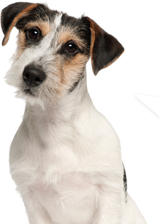Leash Reactivity
We describe a dog as being “leash reactive” when they bark, lunge or growl at specific triggers that they see while on leash. Possible triggers for this behavior include dogs, cats, people, bikes, and wild animals. Modifying this behavior is possible but requires a high level of consistency.
Necessary Supplies:
- A treat pouch
- An abundance of high-value treats (tiny portions of hot dogs, cheese, etc.)
- A 4 to 6-foot leash (no retractable leashes)
- A comfortable, properly-fitted harness
- A waist leash for added security (optional)
- A squeeze tube for added ease of treat delivery (optional)
Step One: Management
It is important to set up a management plan for our leash-reactive dogs so that we can  help them be as successful as possible. Remember, other dog owners will not be aware of the spatial needs of your dog, so you will have to be a “defensive driver” on their behalf. Keep an eye out for other dogs and avoid them at the beginning of your training journey. Walk your dog in open spaces where you can easily see approaching dogs and can turn and walk in the opposite direction if needed. This may mean that walks in busy neighborhoods won’t be possible in the beginning, and that’s OK!
help them be as successful as possible. Remember, other dog owners will not be aware of the spatial needs of your dog, so you will have to be a “defensive driver” on their behalf. Keep an eye out for other dogs and avoid them at the beginning of your training journey. Walk your dog in open spaces where you can easily see approaching dogs and can turn and walk in the opposite direction if needed. This may mean that walks in busy neighborhoods won’t be possible in the beginning, and that’s OK!
You may choose to not walk your dog unless you’re in a training session and provide them physical and mental exercise other ways. This could include playing fetch in a fenced-in yard or on a long line in a dog-free space, taking your dog to an indoor pool to swim (remember to give the facility a heads up that you’ll need a dog-free path to the enclosed pool), or increasing mental enrichment inside with treat dispensing toys (see Enriching Your Dog’s Life Handout for more ideas).
Step Two: Counter-conditioning
You will want to begin your counter-conditioning protocol well outside of your dog’s threshold. Your dog’s threshold is the distance at which they begin to react to their trigger and are unable to take food. We want to start far enough away from the trigger that they can see it but are unlikely to have a reaction. The moment your dog sees the trigger, before they react, begin to feed them. Be sure that they see the trigger FIRST and begin to feed them second. The food should be constant with little to no pause in between each piece. You should continue to feed them until their trigger goes out of sight or until you move them further away from the trigger. This food can be fed directly from your hand or scattered on the ground. Some dogs are more successful with one versus the other, so you can try both and assess which works best for you.
Finding an appropriate training location is critical. Be sure to consider spaces where your dog will see other dogs but won’t be approached by them. This might be a pet store or vet clinic parking lot. If your dog is very reactive, you may even choose to stay in your car for the first few training sessions so that if your dog is struggling, you can simply drive away. Eventually, parks with large, open spaces can be great training locations. These spaces give you the ability to stay far away from dogs and give you the room to avoid a dog directly approaching you.
Step Three: Look at That
Once your dog is showing relaxed body language and eating readily with step two, you can move on to playing “Look at That.” This is a training game that works similarly to step two, but allows the dog to look at the trigger for a longer period of time. Remember, your end goal is for your dog to be calm and non-reactive when they see their trigger(s), so we need to teach them that they can feel relaxed when they acknowledge the presence of those things.
Be sure to have a treat pouch full of high value treats, just as you would for step two. The moment that your dog looks at the trigger, say “yes!” in a bright, happy voice, put a treat in front of their face, and use it as a lure to turn their head away as they lick and chew on the piece of food. When their head is no longer facing the trigger, release the rest of the treat for them to eat. Be prepared: they will immediately look back at the trigger after you release the food into their mouth. The moment they look at the trigger, say “yes!”, put a treat in front of their face, and turn their head away as they lick the treat. Again, when their head is no longer facing the trigger, release the rest of the treat for them to eat.
This is a rapid-fire game that requires you to pay careful attention to your dog. You will continue to say “yes!” the moment that they look at the trigger, turn their head and feed them over and over again, until the trigger disappears or until you guide your dog further away.
Progressing with these skills:
It is important to be patient and work slowly with your dog while modifying their leash reactivity. Your goal will be to work slowly and thoughtfully enough that they do not feel the need to react (remember, we want to build relaxation in the presence of their triggers and setting them up to react is counter-productive). At each distance, be sure that your dog is relaxed and that the work is easy for them. When you see that your dog is comfortable and confident, you can move closer. Be sure that you only move closer to the trigger by a few feet at a time and that you are assessing their comfort at each distance. If your dog becomes stressed or reactive at a distance, you need to move further away. It may be many weeks or months before your dog has the skillset to work in close proximity to other dogs while on leash.
A note about training treats:
This work requires a HIGH level of reinforcement, particularly in the beginning. This means that we must be very thoughtful about when we train and for how long. Keep your sessions short and look for high-value treats that your dog tolerates well. Some dogs can eat hot dog after hot dog without issue, others will need boiled chicken to keep their digestive tracts healthy and happy. You should NEVER take your reactive dog out into the world without your high value training treats. If you are hoping to keep the quantity of treats lower during a session, be sure to take your dog to a space where you are very unlikely to encounter their triggers.
Remember, this is HARD work
This work is incredibly difficult for our reactive dogs. This means that you will need to keep sessions short and give them “off” days. Instead of walking them in spaces where you will encounter their triggers, occasionally stay at home. You can offer enrichment and work on training exercises in the house rather than going on a “training walk.” You can also seek out spaces that you can rent privately to give your dog the chance to explore, sniff, and exercise without the added stress of encountering their triggers. Keep in mind that they will be mentally tired after working in the presence of their triggers; offer them chances to decompress, like working on a frozen, stuffed KONG.
Be kind to yourself
It is absolutely OK (and necessary!) to give yourself breaks, as well. If you don’t feel that you have the energy to support your dog in the presence of their triggers, skip the walk and support your dog with other forms of exercise and enrichment.
If you get surprised by another dog while on your walk, practice a U-Turn. This is a quick turn in the opposite direction. This should be a game for your dog that you have practiced in calm situations so when you need it, it will be automatic.
Teach a U-Turn:
- In a happy tone say, “U-Turn!” and quickly pivot around 180 degrees, patting your leg to encourage your dog to follow you.
- After you have jogged 10-15 feet away from the other dog, reward your dog with a small treat.
It is important that you practice this exercise when there are not dogs around. Then when the time comes and you are surprised by a dog, you can quickly “U-Turn” and get out of the situation.
For a PDF version of this information, click here.
To see a video on leash reactivity, click here.
If you are seeking additional support with your leash reactive dog contact the Wisconsin Humane Society behavior department at 414-431-6173 or email behavior@wihumane.org.
